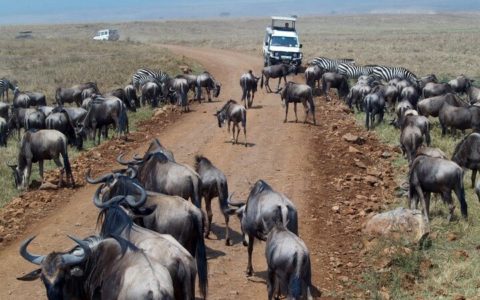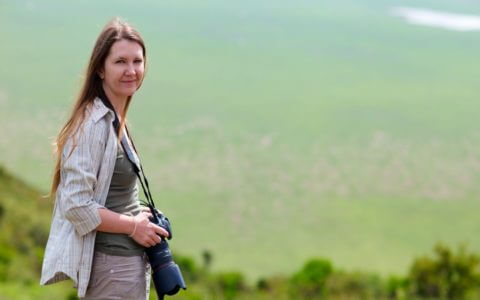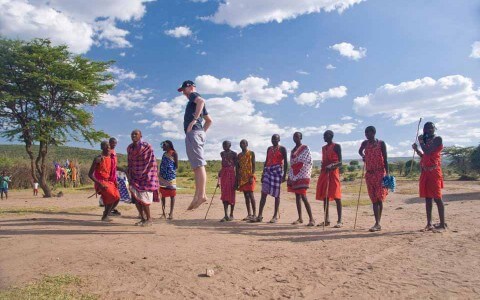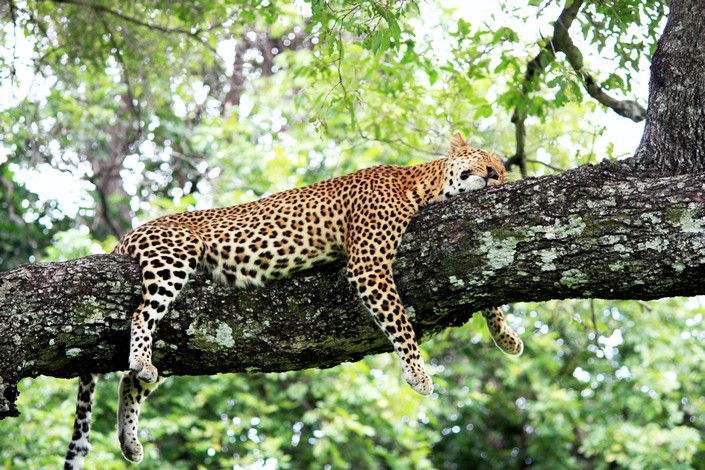If your dream of traveling in Africa looks like the trailer for the live action Lion King, then you’re dreaming of the Serengeti. We don’t blame you. More than anywhere else, this iconic national park is the land of safaris.
It’s the thorny umbrella trees silhouetted against the burnt orange sunset. The idea of golden-maned lions stalking their prey in the endless plains. Or the millions of wildebeest migrating to an ancient call of the wild. Maybe it’s all the above. Whatever your reason for overlanding through East Africa, a safari in Tanzania’s Serengeti will not disappoint.
The Serengeti has earned it’s title as the greatest wildlife-watching destination on earth. Besides the great migration, the park is home to the densest lion population in the world. In addition, all members of the Big Five and almost 500 bird species inhabitant the park. And, while this wildlife extravaganza is enough to lure anyone in, there is much more to the region than game drives.
It would take years to explore the 1.5 million hectares of savannah that this World Heritage Site has to offer. So, we’ve put together a guide of our favorite attractions and places in the Serengeti National Park to help you plan your East African overland tour.
The Moru Kopjes
Like islands in a sea of endless savannah, the Moru Kopjes are an oasis for wildlife in the central Serengeti. Remember that Circle of Life scene in The Lion King? Well, the Moru Kopjes are a bit like that. Only, you won’t see any baboons presenting the future king of Africa’s animal kingdom.
https://www.instagram.com/p/BrrzxXcBmfK/
On the bright side, the ancient rocks are the perfect place to spot wildlife. The trees that rise out of these massive rock formations create small pools of water and shade, making it a favorite location for lions and leopards. Besides the plethora of big cats to spot, this area is also the best place to see the endangered black rhino.
Moru Kopjes is home to the Serengeti National Park’s only black rhino population. This endangered species is on the verge of extinction. But, the herd are monitored by armed anti-poaching rangers and an intense conservation scheme. If you’re passionate about conservation, you can find out more about the Serengeti’s anti-poaching policies at the visitor’s center.
Aside from being a wildlife hotspot, the kopjes also offer a look into the life of the Maasai through ancient cave paintings. These natural caves were used by warriors as a shelter for their livestock or a safe haven for wandering nomads.
https://www.instagram.com/p/BvPBS8JHzcJ/
Olduvai Gorge
The Great Rift Valley is a staple on any Tanzania safari itinerary. Although there are plenty of sites to explore in this massive series of trenches, the Olduvai Gorge is (arguably) the most important.
If you want to get to know the ‘Motherland’ then this is the place to explore. Like an old world version of Silicon Valley, this area was a hub of human innovation. The Olduvai offered the first discovery of traces of an early stone tool culture. It’s so old that it even gave the name to the Oldowan, the oldest-known stone tool.
https://www.instagram.com/p/BtQ8v8clfR1/
This ancient ravine has proven crucial to understanding the evolution of humans and holds the earliest evidence of the existence of human ancestors. Long before the Masai Mara, the first early human species occupied Olduvai Gorge approximately 1.9 million years ago.
Since then the Olduvai Gorge has become one of the most abundant fossil sites in the world. In fact, the theory that human evolution began in Africa is partially thanks to the discovery of hundreds of fossilized bones and stone tools in this area.
From From From From From From From From From From From From From From From From From From From From From From From From From From From From From From From From From From From From From From From From From From From From From From From From From From From From From From From From From From From
Tour Length
31 days
Group Size
Max 16
Starts & Ends
Starts: Nairobi Ends: Pretoria
Countries
Kenya,
Tanzania,
Malawi,
Zambia,
Zimbabwe,
South Africa
Overview
This Nairobi to Kruger Comfort Overland Tour provides insight into some of the finest attractions in East and Southern Africa. Exploring the national parks of Masai Mara, the flat plains of the Serengeti to the stunning beaches of Zanzibar. View the picturesque Lake Malawi and the powerful Victoria Falls. Experience culture and wildlife on this magnificent overland comfort tour.
Kenya to Kruger Comfort Tour (31 Days)
Tour start → end dates
Price
Enquire
02 Jun 2024
→
02 Jul 2024
Check Availability
30 Jun 2024
→
30 Jul 2024
Check Availability
14 Jul 2024
→
13 Aug 2024
Check Availability
28 Jul 2024
→
27 Aug 2024
Check Availability
11 Aug 2024
→
10 Sep 2024
Check Availability
25 Aug 2024
→
24 Sep 2024
Check Availability
08 Sep 2024
→
08 Oct 2024
Check Availability
22 Sep 2024
→
22 Oct 2024
Check Availability
06 Oct 2024
→
05 Nov 2024
Check Availability
20 Oct 2024
→
19 Nov 2024
Check Availability
03 Nov 2024
→
03 Dec 2024
Check Availability
17 Nov 2024
→
17 Dec 2024
Check Availability
01 Dec 2024
→
31 Dec 2024
Check Availability
15 Dec 2024
→
14 Jan 2025
Check Availability
29 Dec 2024
→
28 Jan 2025
Check Availability
12 Jan 2025
→
11 Feb 2025
Check Availability
26 Jan 2025
→
25 Feb 2025
Check Availability
09 Feb 2025
→
11 Mar 2025
Check Availability
23 Feb 2025
→
25 Mar 2025
Check Availability
09 Mar 2025
→
08 Apr 2025
Check Availability
23 Mar 2025
→
22 Apr 2025
Check Availability
06 Apr 2025
→
06 May 2025
Check Availability
20 Apr 2025
→
20 May 2025
Check Availability
04 May 2025
→
03 Jun 2025
Check Availability
18 May 2025
→
17 Jun 2025
Check Availability
01 Jun 2025
→
01 Jul 2025
Check Availability
15 Jun 2025
→
15 Jul 2025
Check Availability
29 Jun 2025
→
29 Jul 2025
Check Availability
13 Jul 2025
→
12 Aug 2025
Check Availability
27 Jul 2025
→
26 Aug 2025
Check Availability
10 Aug 2025
→
09 Sep 2025
Check Availability
24 Aug 2025
→
23 Sep 2025
Check Availability
07 Sep 2025
→
07 Oct 2025
Check Availability
21 Sep 2025
→
21 Oct 2025
Check Availability
05 Oct 2025
→
04 Nov 2025
Check Availability
19 Oct 2025
→
18 Nov 2025
Check Availability
02 Nov 2025
→
02 Dec 2025
Check Availability
16 Nov 2025
→
16 Dec 2025
Check Availability
30 Nov 2025
→
30 Dec 2025
Check Availability
14 Dec 2025
→
13 Jan 2026
Check Availability
28 Dec 2025
→
27 Jan 2026
Check Availability
Tour Length
12 days
Group Size
Max 17
Starts & Ends
Starts: Nairobi Ends: Nairobi
Countries
Kenya,
Tanzania
Overview
Nothing can compare to encountering the legendary wildlife of the Serengeti and Masai Mara in the flesh. That’s why we’ve dedicated 12 full days to exploring this iconic safari circuit.
Traverse incredible national parks where golden grasslands stretch onto the ends of the earth, watch wildebeest kick up the rich African dust as they migrate in their millions, and venture off track to isolated regions to meet local tribes world apart. The road is as diverse as it is unpredictable, so be prepared for adventure.
Your tour requires participation from all group members. This entails assisting with the food preparation, washing of dishes, keeping the truck clean and the setting up the camp. Please keep in mind that flexibility and an open mind is needed on the trip. All guides are registered with the Field Guide Association of Southern Africa (FGASA).
Kenya & Tanzania Budget Safari (All Inclusive)
Tour start → end dates
Price
Enquire
28 Apr 2024
→
09 May 2024
Check Availability
12 May 2024
→
23 May 2024
Check Availability
26 May 2024
→
06 Jun 2024
Check Availability
09 Jun 2024
→
20 Jun 2024
Check Availability
23 Jun 2024
→
04 Jul 2024
Check Availability
07 Jul 2024
→
18 Jul 2024
Check Availability
21 Jul 2024
→
01 Aug 2024
Check Availability
04 Aug 2024
→
15 Aug 2024
Check Availability
18 Aug 2024
→
29 Aug 2024
Check Availability
01 Sep 2024
→
12 Sep 2024
Check Availability
15 Sep 2024
→
26 Sep 2024
Check Availability
29 Sep 2024
→
10 Oct 2024
Check Availability
13 Oct 2024
→
24 Oct 2024
Check Availability
27 Oct 2024
→
07 Nov 2024
Check Availability
10 Nov 2024
→
21 Nov 2024
Check Availability
24 Nov 2024
→
05 Dec 2024
Check Availability
08 Dec 2024
→
19 Dec 2024
Check Availability
22 Dec 2024
→
02 Jan 2025
Check Availability
Lake Natron
Just 4 hours away from the Serengeti National Park lies one of the most inhospitable places on Earth. Lake Natron is one of the most surreal places in the world. Coloured a deep red from salt-loving organisms and algae, the lake is so caustic it can burn the skin and eyes of animals that aren’t adapted to it.
https://www.instagram.com/p/BtU-5FkgM4I/
Despite this, Lake Natron’s alkaline waters support a thriving ecosystem of salt marshes, freshwater wetlands, and wetland birds. But, the surreal area is best known for attracting a flock of 2.5 million lesser flamingos.
The lake’s high salinity means more spirulina for the millions of birds to feast on. And, given the extreme conditions neither predators nor humans can disturb the booming populations of flamingos. The majority of hatching and egg laying takes place during the months of September to April although there is a peak in October to early December.
https://www.instagram.com/p/Bvc_vHEFF6m/
The Bologonja Springs
If you thought that the Big Five were the only animals worth seeing while on a Serengeti safari then think again. Hidden away in the northeast corner of the Serengeti, the Bologna springs are a wildlife mecca.
The springs were discovered in 1913 by Stewart White, who described them as a heaven on earth, and little has changed since then. The fresh waters and verdant greenery attracts hundreds of migrating and resident animals. While the trees support several species of monkey.
The springs also draw larger mammals like elephants and giraffes, as well as a variety of birds and antelope species like the mountain reedbuck and steenbok. This is the perfect place to enjoy the flora and fauna of the Serengeti without having to put up with hordes of tourists.
https://www.instagram.com/p/BPP6sWMjlz4/
Retina Hippo Pool (Central Serengeti)
Wildlife documentaries make lions out to be the most dangerous animal in the Serengeti. Don’t let those mighty roars fool you. The real king of the savannah lies where the Seronera and Orangi rivers converge.
Lurking in these muddy puddles, hippos snooze by the dozens. But their chilled-out demeanor belies how dangerous they are. The hippopotamus is one of Africa’s most dangerous animals and is a must see while on your wildlife safari in Tanzania.
https://www.instagram.com/p/Bs5PWmhFS-t/
The Retina Hippo Pool, north of the Seronera River Valley, is the hangout of roughly 200 hippos and well worth a visit. While some have noted that the smell at the pool can be somewhat overwhelming, don’t let this deter you.
This is one of the few places in the Serengeti National Park where visitors can leave the vehicle and view the animals on foot. Great photography opportunities abound here as the large groups of hippos huddle together and jostle for position in the water. There are plenty of observation points around the river bank, as well as a picnic area where you can take a break…Away from smell.
Lobo Valley
Although lions may not be the king of the savannah, they are still an icon of African wildlife. And, compared to the rest of the Serengeti, the Lobo Valley is the best place to spot them.
Big cats are abounding in this region thanks to the availability of permanent water and food sources. Besides being home to the second largest pride of lions in the Serengeti, the Lobo Valley is also teaming with leopard and cheetah.
https://www.instagram.com/p/Bev92EjlZmK/
Giraffes, elephants, and baboons are also regulars in the Lobo Valley. And from July to November, millions of wildebeest, gazelles and zebras come to the area during the Great Migration.
Now we have given you even more reasons to head to this diverse region of Africa. So be sure to carve out enough time to see all the splendor of the Serengeti, as this National Park has many wildlife wonders to whet your safari appetite!
From From From 15% off! From From From From From From From From From From From From From From From From From From From From From From From From From From From From From From From From From From From From From From From From From From From From From From From From From From From From From From From From From From From From From From From From From From From From From From From From From From From From From From From From From From From From From From From From From From
Tour Length
22 days
Group Size
Max 20
Starts & Ends
Starts: Livingstone Ends: Nairobi
Countries
Zambia,
Malawi,
Tanzania,
Kenya
Overview
Three weeks, five countries, one adventure. This rugged overland tour is your ticket to Africa’s most spectacular highlights. Feeling the heart-pounding thunder of Victoria Falls, the greatness of Lake Malawi, and the suspense of a nocturnal safari in the Serengeti, are all part of the itinerary. Top it off with three days of horizontal me-time on the paradise beaches of Zanzibar and now you’re really living.
Livingstone to Nairobi Tour (Comfort) (22 Days)
Tour start → end dates
Price
Enquire
17 May 2024
→
07 Jun 2024
Check Availability
31 May 2024
→
21 Jun 2024
Check Availability
14 Jun 2024
→
05 Jul 2024
R80750
R68637
Check Availability
28 Jun 2024
→
19 Jul 2024
Check Availability
12 Jul 2024
→
02 Aug 2024
Check Availability
26 Jul 2024
→
16 Aug 2024
Check Availability
09 Aug 2024
→
30 Aug 2024
Check Availability
23 Aug 2024
→
13 Sep 2024
Check Availability
06 Sep 2024
→
27 Sep 2024
Check Availability
20 Sep 2024
→
11 Oct 2024
Check Availability
04 Oct 2024
→
25 Oct 2024
Check Availability
18 Oct 2024
→
08 Nov 2024
Check Availability
01 Nov 2024
→
22 Nov 2024
Check Availability
15 Nov 2024
→
06 Dec 2024
Check Availability
29 Nov 2024
→
20 Dec 2024
Check Availability
13 Dec 2024
→
03 Jan 2025
Check Availability
27 Dec 2024
→
17 Jan 2025
Check Availability
10 Jan 2025
→
31 Jan 2025
Check Availability
24 Jan 2025
→
14 Feb 2025
Check Availability
07 Feb 2025
→
28 Feb 2025
Check Availability
21 Feb 2025
→
14 Mar 2025
Check Availability
07 Mar 2025
→
28 Mar 2025
Check Availability
21 Mar 2025
→
11 Apr 2025
Check Availability
04 Apr 2025
→
25 Apr 2025
Check Availability
18 Apr 2025
→
09 May 2025
Check Availability
02 May 2025
→
23 May 2025
Check Availability
16 May 2025
→
06 Jun 2025
Check Availability
30 May 2025
→
20 Jun 2025
Check Availability
13 Jun 2025
→
04 Jul 2025
Check Availability
27 Jun 2025
→
18 Jul 2025
Check Availability
11 Jul 2025
→
01 Aug 2025
Check Availability
25 Jul 2025
→
15 Aug 2025
Check Availability
08 Aug 2025
→
29 Aug 2025
Check Availability
22 Aug 2025
→
12 Sep 2025
Check Availability
05 Sep 2025
→
26 Sep 2025
Check Availability
19 Sep 2025
→
10 Oct 2025
Check Availability
03 Oct 2025
→
24 Oct 2025
Check Availability
17 Oct 2025
→
07 Nov 2025
Check Availability
31 Oct 2025
→
21 Nov 2025
Check Availability
14 Nov 2025
→
05 Dec 2025
Check Availability
28 Nov 2025
→
19 Dec 2025
Check Availability
12 Dec 2025
→
02 Jan 2026
Check Availability
26 Dec 2025
→
16 Jan 2026
Check Availability
Tour Length
13 days
Group Size
Max 16
Starts & Ends
Starts: Nairobi Ends: Dar es Salaam
Countries
Kenya,
Tanzania
Overview
With showpiece attractions by the likes of the Serengeti, Ngorongoro Crater, and Mount Kilimanjaro, East Africa is story-book Africa. This whirlwind adventure sees you living out your wildest dreams with open-top game drives through vast plains and eye-opening Masaai village tours. After getting your fill of wildlife and local living, dust off your boots and soak up the African sun on the powdery-white beaches of Zanzibar. Now this is a dream come true.
13 Day East Africa Game Parks and Zanzibar Safari
Tour start → end dates
Price
Enquire
02 Jun 2024
→
14 Jun 2024
Check Availability
11 Aug 2024
→
23 Aug 2024
Check Availability
08 Sep 2024
→
20 Sep 2024
Check Availability
22 Sep 2024
→
04 Oct 2024
Check Availability
06 Oct 2024
→
18 Oct 2024
Check Availability
20 Oct 2024
→
01 Nov 2024
Check Availability
03 Nov 2024
→
15 Nov 2024
Check Availability
17 Nov 2024
→
29 Nov 2024
Check Availability
01 Dec 2024
→
13 Dec 2024
Check Availability
15 Dec 2024
→
27 Dec 2024
Check Availability
29 Dec 2024
→
10 Jan 2025
Check Availability
12 Jan 2025
→
24 Jan 2025
Check Availability
26 Jan 2025
→
07 Feb 2025
Check Availability
09 Feb 2025
→
21 Feb 2025
Check Availability
23 Feb 2025
→
07 Mar 2025
Check Availability
09 Mar 2025
→
21 Mar 2025
Check Availability
23 Mar 2025
→
04 Apr 2025
Check Availability
06 Apr 2025
→
18 Apr 2025
Check Availability
20 Apr 2025
→
02 May 2025
Check Availability
04 May 2025
→
16 May 2025
Check Availability
18 May 2025
→
30 May 2025
Check Availability
01 Jun 2025
→
13 Jun 2025
Check Availability
15 Jun 2025
→
27 Jun 2025
Check Availability
29 Jun 2025
→
11 Jul 2025
Check Availability
13 Jul 2025
→
25 Jul 2025
Check Availability
27 Jul 2025
→
08 Aug 2025
Check Availability
10 Aug 2025
→
22 Aug 2025
Check Availability
24 Aug 2025
→
05 Sep 2025
Check Availability
07 Sep 2025
→
19 Sep 2025
Check Availability
21 Sep 2025
→
03 Oct 2025
Check Availability
05 Oct 2025
→
17 Oct 2025
Check Availability
19 Oct 2025
→
31 Oct 2025
Check Availability
02 Nov 2025
→
14 Nov 2025
Check Availability
16 Nov 2025
→
28 Nov 2025
Check Availability
30 Nov 2025
→
12 Dec 2025
Check Availability
14 Dec 2025
→
26 Dec 2025
Check Availability
28 Dec 2025
→
09 Jan 2026
Check Availability
Tour Length
10 days
Group Size
Min 2 Max 7
Starts & Ends
Starts: Arusha Ends: Nairobi
Countries
Kenya,
Tanzania
Overview
This 10 day Best of Tanzania and Kenya Safari covers many highlights of northern Tanzania and Kenya. You travel to the Tarangire National Park, Masai Mara Game Reserve and end in Nairobi. You will be staying in Tented Camps.
Best of Tanzania & Kenya Safari in Tented Camps (10 Days)
Tour start → end dates
Price
Enquire
05 May 2024
→
14 May 2024
Check Availability
19 May 2024
→
28 May 2024
Check Availability
02 Jun 2024
→
11 Jun 2024
Check Availability
16 Jun 2024
→
25 Jun 2024
Check Availability
30 Jun 2024
→
09 Jul 2024
Check Availability
14 Jul 2024
→
23 Jul 2024
Check Availability
28 Jul 2024
→
06 Aug 2024
Check Availability
11 Aug 2024
→
20 Aug 2024
Check Availability
25 Aug 2024
→
03 Sep 2024
Check Availability
08 Sep 2024
→
17 Sep 2024
Check Availability
22 Sep 2024
→
01 Oct 2024
Check Availability
06 Oct 2024
→
15 Oct 2024
Check Availability
15 Dec 2024
→
24 Dec 2024
Check Availability












0 Comments